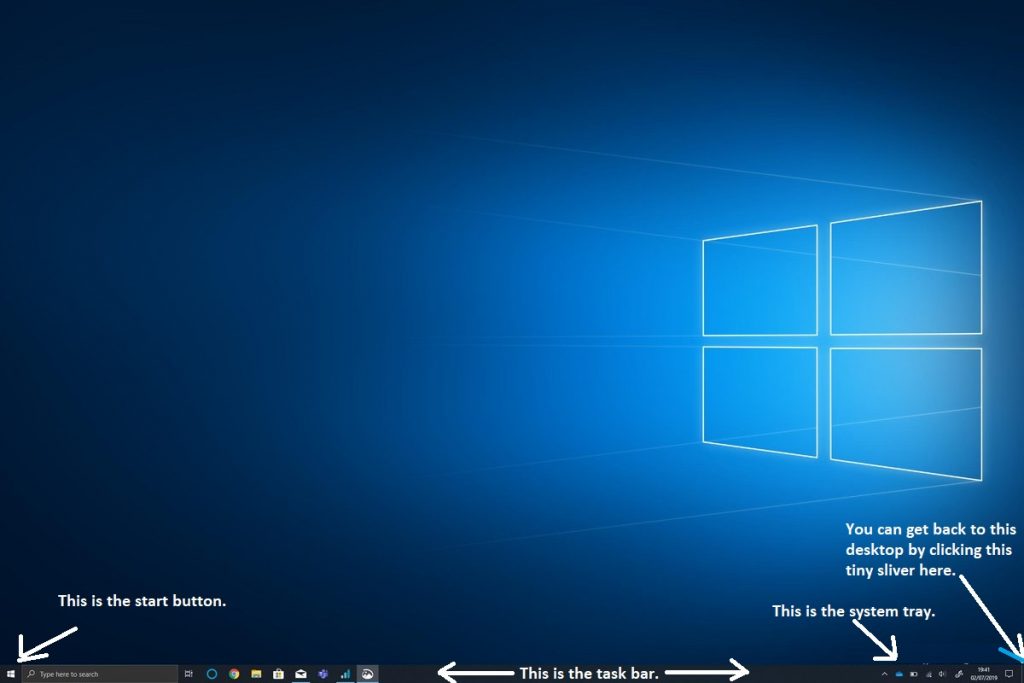Windows is an operating system built by Microsoft. Operating systems are software installed on a computer which handles the display, navigation, and commands a person can use. Apple uses the Mac operating system and both Windows and Mac have similarities. You have probably heard of various versions of Windows such as Windows XP, Windows 7, and Windows 10. We are focusing on Windows 10 since that is what is installed on the PC’s and laptops in our technology centers.
Windows uses a graphical user interface (GUI) which allows users to interact with the software visually instead of typing commands. Before the mouse was invented, people had to type commands to get software to run. The mouse has been the predominant tool to interact with software until the touchscreen was invented and made popular on cell phones.

Learning to navigate Windows operating system will help you with a lot of other software which has used Windows as its basis for navigation. This is because Microsoft has embedded itself into government offices including education – this means everyone has to use it if they want to interact with the government or public education. Since most people prefer to use things they are familiar with, Windows continues to be the main operating system to this day.
The main components of Windows are drives, directories, and files. Thankfully, Windows is designed similarly to things we use in the real world. Windows is set up like a house. Inside the house, there are various rooms to store things (drives). There is usually a main drive called the C drive. The main drive holds most of the software on the computer. Other drives can be added and they are named the next letter available.
When you start a computer with Windows on it, you will see something like this:
Some things will be different but here are the things that will be the same on most computers with windows on it. When you sign into a Windows 10 PC or laptop, you will see the desktop:

When you click on the start button with your mouse (or finger on a touchscreen), a menu of software and settings will show up. The task bar shows any software that is open. The taskbar also holds various shortcuts (kind of like a bookmark) to things you use most often. The system tray shows the current time, battery status (for laptops), volume, and wifi/internet access icons. The very bottom right corner of the screen has a button to bring you back to this desktop area even if you have other software or files open. Many people put short cuts to their favorite software on this screen and sometimes files they need most often.
You can hover (move your mouse pointer but don’t click) over each of the icons to see what they are.
When you click on the folder, a screen opens on top of the desktop. This is actually called a window, thus the name of the operating system. Becoming comfortable with this interface is crucial to being able to find your way around. The top of the window tells you what the window is showing, in this case its the File Explorer. Directly below the name of the window is the Menu bar. This is where you will find basic commands that are often used within the window. Below the menu bar is the address bar. More about this bar is explained in a lesson about saving files. The window controls on the top right will minimize, restore down, or close the window. Minimizing moves the window to the task bar, its still open but out of the way. You can maximize the window so it takes up your whole screen. Restore down makes the window smaller. The window controls will always be in the top right of the window screen no mater what size it is. The close button actually closes the window.

The side area shows various shortcuts and directories (folders) where files such as documents and images are stored. When you click on any of the directories in the navigation pane, the contents of that directory or folder shows up to the right. This navigation pane makes it easy to flip through various folders without closing the window and starting over.
Getting used to navigating with windows is worth the effort. To do this, you will need to learn to use the mouse, a touch pad (on laptops), and a touch screen to click, double click, right-click, and drag (holding the button down while moving). These are kids games but will help you get used to using a mouse, touch pad, and touch screen: https://www.norwood.k12.ma.us/~dmiller@norwood.k12.ma.us/teacher-site/keyboarding-and-mouse-practice
